#chinese virtues
Text
i don´t think china is per se imperialist but the thing is when you participate in global trade this much in the conditions of the imperialists you will end up participating in exploitation in some level. no ethical international trade under capitalism
#i mean guevara critiqued the soviets because by virtue of trading under the world system they contributed to the unequal exchange to a degre#e and china is much more integrated than the ussr ever was#i know why chinese foreign policy is like this but it doesnt mean i got to like it#rare santi direct opinion regarding modern china
26 notes
·
View notes
Text

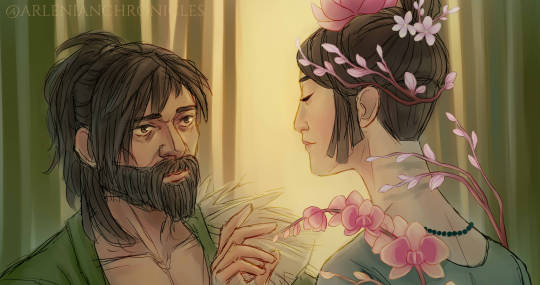
Post-true ending art for Sifu, this time with Fajar! Along with the MC turning the bosses into allies, I love the idea of her displaying the respective Five Virtues that each boss is associated with and lacks in-game.
In Fajar's case, it's Humanity, more commonly known as Benevolence, iirc. He offed the MC when she was only a child, and we never find out how he feels about the deed, though the spare option implies that he probably felt guilty about it for years afterward. I suspect he only did it because Yang asked him to, and Fajar trusted him (just as he trusts Yang to treat his illness).
The MC sparing Fajar can be seen as an act of humanity (and benevolence), but I like to take it further and imagine that she went back to Fajar after, and they somehow formed a sort of "gremlin uncle and compassionate niece" dynamic, if that makes sense XDD
I'm also not sure how to explain what's going on in my painting; I just wanted to draw Fajar experimenting with some pretty flowers other than the purple ones used to make drugs lmaoo and the MC supports his endeavours! :D
#art#my art#fantasy#illustration#fantasy illustration#fanart#sifu#sifu game#sifu fanart#sloclap#kung fu#video game#video game fanart#chinese characters#flowers#lotus#cherry blossom#orchid#water lily#the thing with the five virtues is also included in my sifu fic XD#touching upon those concepts from the game was lots of fun!
29 notes
·
View notes
Text
god I wish anyone actually fucking cared about the environment. our green party isn't even a fucking joke; it's purely an instrument of the republican establishment to elect more republicans who are even worse for the environment, leveraging the fact that apparently your average american voter understands zero game theory and is just that fucking bad at math.
#some of you made not doing your homework your entire identity and look where we fuckin are#standardized tests are Chinese and a lot of math was pioneered by the Arab world but nooo. we decided being angry and ignorant was a virtue#text#us politics
7 notes
·
View notes
Text
"Be loyal and trustworthy. Do not befriend anyone who is lower than yourself in this regard. When making a mistake, do not be afraid to correct it."

Confucius, born Kong Qiu was a Chinese philosopher of the Spring and Autumn period who is traditionally considered the paragon of Chinese sages. Confucius's teachings and philosophy underpin East Asian culture and society, and remain influential across China and East Asia to this day.
Born: Qufu, Jining, China
Died: Lu, China
Life and Times: Confucius, also known as Kong Fuzi or Master Kong, lived during the Spring and Autumn period of Chinese history, around 551–479 BCE. He was born in the state of Lu (modern-day Shandong, China) during a time of political and social unrest.
Founder of Confucianism: Confucius is considered the founding figure of Confucianism, a philosophical and ethical system that emphasizes the importance of moral values, social harmony, and the cultivation of virtue. His teachings are primarily compiled in a collection known as the "Analects."
Five Relationships: Confucius emphasized the importance of social harmony through the concept of the Five Relationships, which include ruler-subject, father-son, husband-wife, elder brother-younger brother, and friend-friend. Maintaining proper conduct within these relationships was seen as essential for a harmonious society.
Ren and Li: Two key concepts in Confucianism are "Ren" and "Li." Ren refers to benevolence or compassion, emphasizing the quality of humaneness and the importance of cultivating virtuous relationships. Li encompasses rituals and proper conduct, emphasizing the importance of social etiquette and moral propriety.
Legacy and Influence: Confucius' teachings have had a profound and lasting impact on Chinese culture, ethics, and philosophy. Confucianism became a central part of Chinese thought and greatly influenced the moral and social fabric of East Asian societies. Even today, Confucian principles continue to shape aspects of Chinese culture and governance.
#Confucianism#Analects#Chinese philosophy#Confucian ethics#Sage#Filial piety#Five Relationships#Ren (benevolence)#Li (ritual)#Xiao (filial piety)#Confucius sayings#Classical Chinese thought#Moral philosophy#Virtue#Social harmony#Education in Confucianism#Confucian values#Eastern philosophy#Chinese culture#Master Kong (Kong Fuzi)#quoteoftheday#today on tumblr
4 notes
·
View notes
Text

If one follows the path of Tao, if one follows the natural processes of the heavens and the earth, one can easily control the whole world.
Huaj-nan-ce
#art#ai art#ai artist#ai art gallery#ai art generator#graphic design#ai artwork#ai image#artwork#Philosophy#Chinese Philosophy#Path and virtue
3 notes
·
View notes
Text
For #FroggyFriday:


Qi Baishi (1864-1957), Flowering Calamus and #Frogs, 1950. Hanging scroll; ink on paper. Dimensions: Image: 40 1/4 x 13 5/8 in. (102.2 x 34.6 cm): Overall with mounting: 99 1/8 x 20 7/8 in. (251.8 x 53 cm); Overall with knobs: 99 1/8 x 24 5/8 in. (251.8 x 62.5 cm). From the Noble Virtues: Nature as Symbol in Chinese Art exhibition at Metropolitan Museum of Art, New York.
“Qi Baishi often painted fish, crabs, and shrimp in the early years of his Beijing period (ca. 1920–57), but he seldom painted frogs. As a professional artist, he had to cater to the popular demand for sets of four hanging scrolls, so frogs became his fourth aquatic animal. The frogs in this painting face one another as if engaged in conversation in front of the calamus plant, which is indigenous to their watery habitat. Qi inscribed it with a couplet:
By the Starry Pond [Xingdou Tang] were three houses,
Where sons and grandsons knew the calamus flowers.
(trans. by Shi-yee Liu)”
[info via The Met]
#frog#frogs#amphibians#Chinese art#East Asian art#Asian art#20th century art#hanging scroll#ink and paper#works on paper#Qi Baishi#1950s#Metropolitan Museum of Art New York#Noble Virtues: Nature as Symbol in Chinese Art#exhibition#museum visit#Froggy Friday#animals in art
9 notes
·
View notes
Photo

Happy Lunar New Year from your favourite moon bunny!
#zero escape#virtue's last reward#lagomorph#zero III#999#9 Hours 9 Persons 9 Doors#zero iii virtue's last reward#zero 3 virtue's last reward#the nonary games#fan art#VLR#lunar new year#chinese zodiac#chinese new year#year of the rabbit#2023
8 notes
·
View notes
Text
How to fix Warriors of Virtue
1. Dump the bullies making Ryan risk his life. They can be just bullies, not psychopaths.
2. Make Ryan Asian. He can stay twelve, American and even named Ryan, but dump the nineties cliche of “lost white boy finds enlightenment”.
3. Make Ming Ryan’s big brother instead of a random adult friend with no explanation of how they became so close in the first place.
4. Make Ryan’s family originally from Tao. They could’ve been appointed guardians of the mystic book and sent to Earth to keep it out of Komodo’s hands. The rest of the family thinks Ryan’s too young to know the truth but Ming wants to send him to Tao to get his leg fixed so he won’t be bullied anymore. He sends his little brother back without their elders consent or knowledge.
5. Ryan can arrive in Tao to find it at war with Komodo just like in the original film, but instead of a random white guy, make Komodo his dad. This adds an extra reason why Master Chung choose Ryan’s family to be the guardians of the book, he was also trying to protect them from Komodo’s evil choices and possible aggression from his victims. Also it gives Ryan a dilemma. He wants a relationship with his father, who can also heal his leg, but the people of Tao are in the right, but they can’t heal his leg.

6. Dump the romance between Elysia and Komodo, the age difference is WAY too great and very creepy. Instead, have her be Komodo’s apprentice in magic and like a daughter to him. This reinforces the sibling-like love she feels for Ryan and explains why she believes Komodo will help her avenge her blood brother.
7. Have Komodo let it slip that he actually killed Elysia’s brother and framed Yun for the crime, to cause dissension amongst the Warriors of Virtue and bring Elysia over to his side. Elysia and Ryan are heartbroken by this and help the Roos to escape back to Master Chung’s Lifespring.
8. They arrive to find Ryan’s Mother and Ming have arrived to fetch him home but he convinces them to join the last battle. They, Elysia, the citizens of the Lifespring, and the Roos are victorious and the bonds of love and respect in Ryan’s family are made even stronger for it. Komodo can still have his second chance at redemption, because morals I guess. With the threat gone, they can stay in Tao, but they’ve grown to love their life on Earth and wish to return. But Ryan promises to visit the Roos and Elysia.
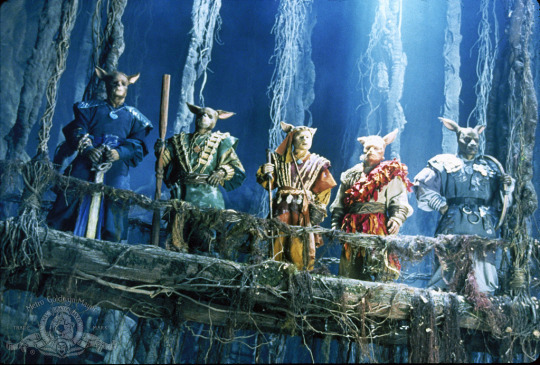
#Warriors of Virtue#kung fu kangaroos#ninties#obscure movie#my childhood#chinese movie#fix it#wasted potential
9 notes
·
View notes
Text
Lunar New Year 2023 - the Year of the Rabbit
“Happy New Year!” That’s what we said to our hostess at Pao’s Chinese Restaurant on Sunday. The moment we said those words, her eyes brightened. She said: “Oh, I have something for you!” When she returned, she had red envelopes for each of us. She explained: “This is tradition!”
In my inquisitive manner, I had to google the red envelope and its contents. In Middle East countries (and here in…

View On WordPress
#blog#cash#children#Christian virtues#christians#gift giving#good will#gratuity#Happy New Year#inspiration#kindness#love#Love Your Neighbor#Lunar New Year 2023#Pao&039;s Chinese Restaurant#peace#RED#red envelopes#tradition#values#Year of the Rabbit
2 notes
·
View notes
Text
taiwanese ppl picking english names is so funny
there's 3 categories:
basic: tom, david, mark, emily, jessica
This Is Not Normally A Name: baby, candy, cherry
weirdly culturally specific: richart with a t, erich (specifically the german spelling),,
#the ho rambles#i swear taiwanese girls love the name cherry. so many cherrys.#there's also the occasional christian virtue name#or japanese name. lol#tangent but it's very popular among young people these days to have a 'japanese looking' (<- sometimes questionable) online name#like yes yes chinese names arent sexy enough you want to be called ai-chan. weebs. all of you.
1 note
·
View note
Text
For Vietnamese and Chinese versions, please check out:
https://ngocnga.net/buddhism/?utm_source=tumblr&utm_medium=social&utm_campaign=quote
🌟🙏📜
Something more important than ability is character, is morality. Those with morality will have blessings, so Buddhism teaches us to cultivate both blessings and wisdom.
//
Yǒu yīyàng dōngxī bǐ nénglì zhòngyào, jiùshì rén pǐn, jiùshì dàodé, yǒu dàodé de réncái huì yǒufú fen, suǒyǐ fófǎ ràng wǒmen fú huì shuāngxiū.
#1quotein3languages#chineselanguage#learnchinese#learnmandarin#studychinese#chinesewords#putonghua#weibo#chinese#mandarin#pinyin#quotes#quote#Buddhism#Virtue#Wisdom
1 note
·
View note
Text
I saw this book entitled "Plants Have So Much to Give Us, All We Have to Do is Ask" by Mary Siisip Genuisz and i thought oh I HAVE to read that. The author is Anishinaabe and the book is all about Anishinaabe teachings of the ways of the plants.
Going from the idiotic, Eurocentric, doomerist colonialism apologia of that "Cambridge companion to the anthropocene" book, to the clarity and reasonableness of THIS book, is giving me whiplash just about.
I read like 130 pages without even realizing, I couldn't stop! What a treasure trove of knowledge of the ways of the plants!
Most of them are not my plants, since it is a different ecosystem entirely (which gives me a really strikingly lonely feeling? I didn't know I had developed such a kinship with my plants!) but the knowledge of symbiosis as permeating all things including humans—similar to what Weeds, Guardians of the Soil called "Nature's Togetherness Law"—is exactly what we need more of, exactly what we need to teach and promote to others, exactly what we need to heal our planet.
She has a lot of really interesting information on how knowledge is created and passed down in cultures that use oral tradition. The stories and teachings she includes are a mix of those directly passed down by her teacher through a very old heritage of knowledge holders, stories with a newer origin, and a couple that have an unknown origin and (I think?) may not even be "authentically" Native American at all, but that she found to be truthful or useful in some way. She likes many "introduced" plants and is fascinated by their stories and how they came here. (She even says that Kudzu would not be invasive if we understood its virtues and used it the way the Chinese always have, which is exactly what I've been saying!!!)
She seems a bit on the chaotic end of the spectrum in regards to tradition, even though she takes tradition very seriously—she says the way the knowledge of medicinal and otherwise useful plants has been built, is that a medicine person's responsibility is not simply to pass along teachings, but to test and elaborate upon the existing ones. It is a lot similar to the scientific method, I would call it a scientific method. Her way of seeing it really made me understand the aliveness of tradition and how there is opportunity, even necessity, for new traditions based upon new ecological relationships and new cultural connections to the land.
I was gut punched on page 15 when she says that we have to be careful to take care of the Earth and all its creatures, because if human civilization destroys the biosphere the rocks and winds will be left all alone to grieve for us.
What a striking contrast to the sad, cruel ideas in the Cambridge companion of the Anthropocene, where humans are some kind of disease upon the Earth that oppresses and "colonizes" everything else...!...The Earth would GRIEVE for us!
We are not separate from every other thing. We have to learn this. If I can pass along these ideas to y'all through my silly little posts, I will have lived well.
#symbiosis#the ways of the plants#you are a caretaker#you are not separate from every other thing#indigenous literature#books
3K notes
·
View notes
Text
"If you hate a person, then you're defeated by them."

Confucius was a Chinese philosopher and politician of the Spring and Autumn period who is traditionally considered the paragon of Chinese sages. Confucius's teachings and philosophy underpin East Asian culture and society, remaining influential across China and East Asia to this day.
#Hate#Defeat#Emotions#Anger#Resentment#Power#Control#Personal growth#Healing#Resolution#quoteoftheday#today on tumblr#Confucius#Philosophy#Ethics#Morality#Virtue#Filial piety#Analects#Chinese culture#Education#Social harmony#Relationships#Wisdom#Learning#Self-cultivation#Confucianism
5 notes
·
View notes
Text
Welcome to The Journey to the West (西游记) Daily!
You are about to beging a reading journey to get the hidden Buddhist texts accompanied by the monk Tang Sanzang, Sun Wukong, Sha Wujing, Zhu Bajie and Bai Long Ma.
To beging this journey you must subscribe to the newsletter, which you will find at https://journeytothewestdaily.substack.com/. You wil receive your first email this week, welcoming you and sharing information about what's to come and what I will include in the emails.
However, beforehand I want to tell you already that you won't receive a daily email, despite the name of the newsletter. The chapters are dense and full of references to folklore or religion references that you might be unfamiliar with, so you will receive an email every 2 or 3 days maximum.
If this is the first time that you hear about this newsletter and you don't know what Journey to the West is...
The classical Chinese novel Journey to the West is an extended account of the legendary pilgrimage of the Tang dynasty Buddhist monk Xuanzang, who traveled to the "Western Regions" (Central Asia and India) to obtain Buddhist sūtras (sacred texts) and returned after many trials and much suffering. Gautama Buddha gives this task to the monk, whose name in the novel is Tang Sanzang, and provides him with three protectors who agree to help him as an atonement for their sins. These disciples are the Monkey King, Zhu Bajie, and Sha Wujing, together with a dragon prince who acts as the monk's steed, a white horse. The group of pilgrims journey towards enlightenment by the power and virtue of cooperation.
The novel is perfect for the epistolary format, since it's is divided in different and disconnected adventures, so you don't have to always remember what happened in the previous chapter to read the next!
We'll be reading Anthony C. Yu's translation since it is the first unabridged version that we have available in English. It is about 100 chapters long.
As I said, you will receive a first email as soon as you subscribe and an introductory email in a few days. Please, share this post so more people can read along. Use the hashtag #jttwdaily if you want to comment your impressions. I'll share the most important dates soon.
May the Buddha help you in your endeavours.
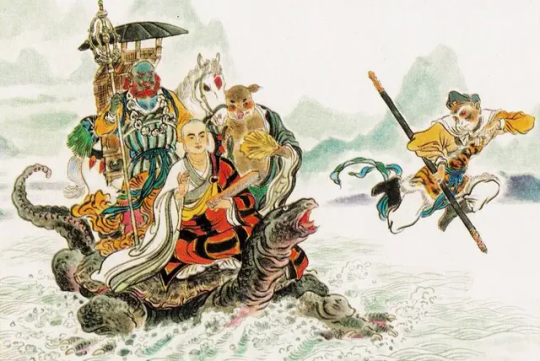
#journey to the west#journey to the West daily#jttwdaily#西游记#Dracula daily#chinese literature#classical Chinese literature#cdrama#the untamed
4K notes
·
View notes
Text


#fantasy#heavenly#celestial#eternity#chinese mythology#chinese culture#mythology and folklore#asian#confucianism#Virtues#confucian#confucius
1 note
·
View note
Text
#FishyFriday:
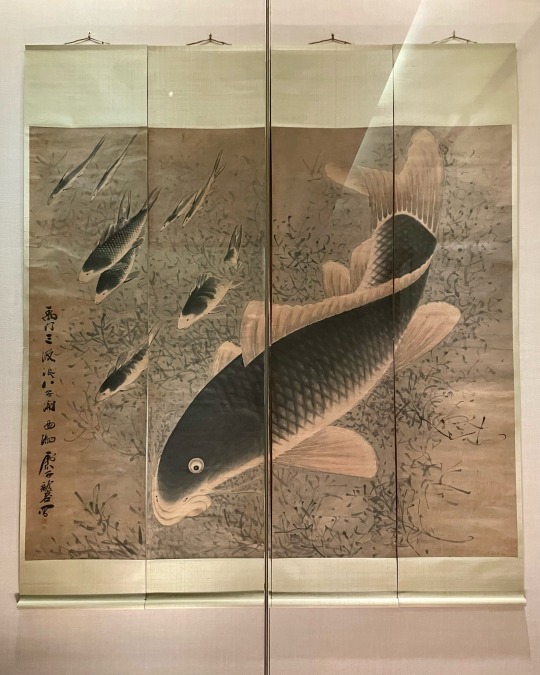
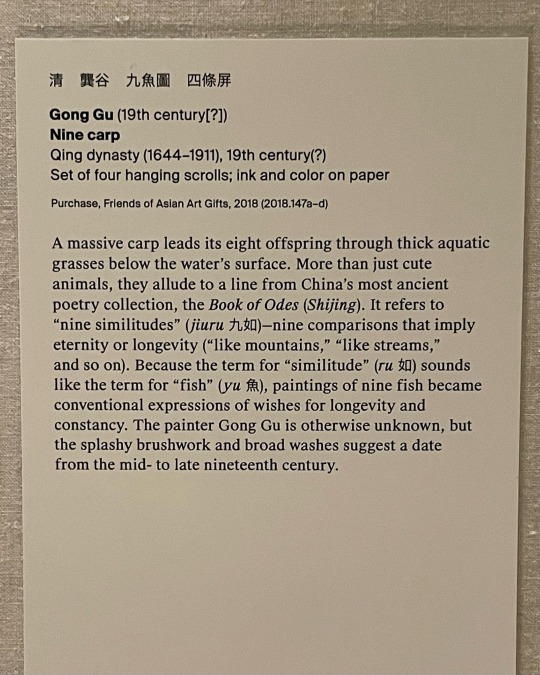
Gong Gu (Chinese, 19th. c.?)
Nine Carp
Qing dynasty, 19th century(?)
Set of four hanging scrolls; ink & color on paper
Metropolitan Museum of Art, New York
"A massive carp leads its eight offspring through thick aquatic grasses below the water’s surface. More than just cute animals, they allude to a line from China’s most ancient poetry collection, the Book of Odes (Shijing). It refers to 'nine similitudes' (jiuru 九如)—nine comparisons that imply eternity or longevity ('like mountains,' 'like streams,' and so on). Because the term for 'similitude' (ru 如) sounds like the term for 'fish' (yu 魚), paintings of nine fish became conventional expressions of wishes for longevity and constancy. The painter Gong Gu is otherwise unknown, but the splashy brushwork and broad washes suggest a date from the mid- to late nineteenth century."
-from the The Metropolitan Museum of Art's “Noble Virtues: Nature as Symbol in Chinese Art” exhibition
#fish#carp#Chinese art#East Asian art#Asian art#19th century art#hanging scroll#Qing dynasty#Gong Gu#Metropolitan Museum of Art New York#museum visit#exhibition#Noble Virtues: Nature as Symbol in Chinese Art#Fishy Friday#works on paper#ink and paper#wordplay#The Book of Odes#Shijing#Chinese literature#animals in art
2 notes
·
View notes